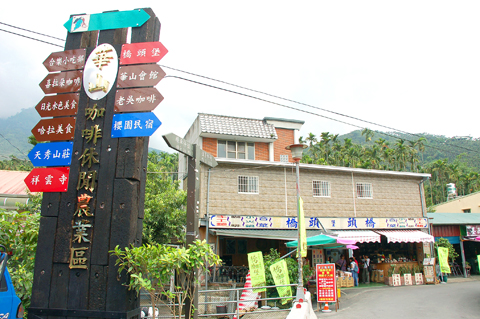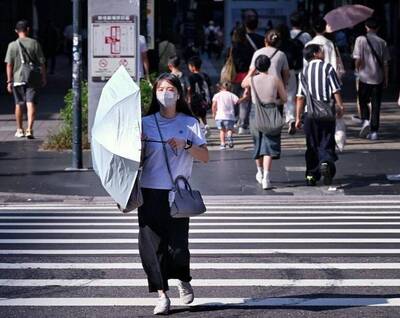When a magnitude 7.3 earthquake rocked central Taiwan on Sept. 21, 1999, Huashan Village (華山) in Yunlin County’s Gukeng Township (古坑) was initially spared, because it was far enough away from the quake’s epicenter to withstand the blow.
In the days that followed, however, Huashan was battered by a series of landslides. The quake had shaken loose soil and trees on nearby mountain slopes and typhoons sent them cascading down into the village and the surrounding area. Roads crumbled and houses, buildings and bridges collapsed under the weight of the buckling mountains.
Since then, Huashan has pulled itself out of a nightmare to become a prosperous community, fueled by a crop that was the town’s trademark decades and even centuries earlier: coffee beans.

PHOTO: CNA
The coffee trade has enabled Huashan to reposition itself as a tourist destination with its famous Taiwan Coffee Festival, forest landscapes, beautiful walkways and Koji pottery art.
With the help of the Yunlin County Government and NT$600 million (US$18.2 million) from the Soil and Water Conservation Bureau, the township also built the country’s first debris flow education garden three years later.
The garden, which features natural landscapes and flood drainage facilities, is a model for the control and prevention of debris flow, said Yunlin County Councilor Hsieh Su-ya (謝淑亞), who played an important role in Huashan’s rebirth as head of Gukeng Township between 1998 and 2006.
The unique showcase not only helps protect the safety of village residents but also boosts the local economy, she said.
Many of the park’s water conservation features, such as sabo, slit and sediment control dams, were environmentally engineered and built with locally available mud and gravel to prevent flooding, Hsieh said.
Though the garden has become a landmark and has had a positive economic effect, it is coffee that sparked Huashan’s economic revival.
“The transformation of Gukeng to prosperity did not happen overnight,” Hsieh said, recalling how hard she tried to create a unique agricultural brand for the township even before the earthquake hit.
She considered oranges, bamboo shoots and tea, but after a meeting in 1998 with Chang Lai-en (張來恩), a coffee farmer in Gukeng’s Hebaoshan (荷苞山) region, Hsieh embraced the crop’s potential because it evoked memories of Gukeng as a coffee growing town.
“Suddenly the answer arrived as though a gift from the gods,” she said. “I realized at that moment that coffee was the best fit for us to go from traditional farming to recreational agriculture or agrotourism.”
The 50-something Chang said Gukeng was already planting coffee when the Dutch occupied Taiwan in the 17th century, and because of its high quality, its harvest was all shipped overseas.
Hebaoshan, nicknamed “Coffee Hill,” and the surrounding area used to be covered by coffee plants, he said.
The golden age of Taiwan’s coffee industry began in 1902, when the colonial Japanese government decided to develop the crop, mainly in Gukeng, which had suitable soil and a subtropical climate.
Though Hsieh had taken to the idea of coffee in 1998, little was done until Huashan was shaken by the 921 Earthquake and subsequent landslides.
Farmers were encouraged by the local government to plant coffee to protect the topsoil, said coffee grower Chung Chiu, who previously grew bamboo shoots.
“So we switched to coffee growing,” Chung said. “Coffee was our best hope to pull us together after the disasters.”
It wasn’t until four years later, however, that the community made a name for itself when Hsieh launched the “Taiwan Coffee Festival” at a cost of NT$3 million.
The event raised the profile of both the township and coffee industry and generated NT$200 million for the local economy. Over the next two years, revenue from the festival rose to about NT$400 million and then NT$1 billion.
Building on the success of the festival, the Gukeng Farmers’ Association inaugurated a recreational agricultural center in October 2003, Hsieh said.
Another draw, the Literature Walkway, a brainchild of writer Ku Meng-jen (古蒙仁), was inaugurated in 2004 when Ku was chief of the Yunlin County Cultural Affairs Department. A year later, Ku launched the Huashan Poet Festival.
The walkway runs a distance of more than 600m and matches works of famous writers set in Yunlin County with the beautiful surrounding landscape. The combination of nature and literature, along with the lure of local coffee, attracted an estimated 1 million tourists a year to the mountain village of 35,000 inhabitants for much of the decade.
More than 100 coffee shops and homestays have been set up in the greater Huashan region, reaping a good share of the hundreds of millions of dollars tourists bring into the area annually.
“Our business is booming, with a good number of visitors coming to Huashan just to enjoy a cup of coffee,” said Lai Song-chi (賴松志), a coffee shop operator who settled in Huashan after the 921 Earthquake.
Huashan’s economic prosperity, however, has not been immune to the country’s economic slump, as tourist numbers have plummeted in the past year.
Hsieh says the region must find innovative ways to revitalize itself again, such as improving coffee growing and roasting techniques, integrating sightseeing resources, developing regional agricultural products and tour itineraries, and improving the quality of tourist attractions.
But is hard to believe that any of those measures will live up to the tremendous boost the humble coffee bean gave to Huashan in pulling it out of its nightmare after the 921 Earthquake.

Three Taiwanese airlines have prohibited passengers from packing Bluetooth earbuds and their charger cases in checked luggage. EVA Air and Uni Air said that Bluetooth earbuds and charger cases are categorized as portable electronic devices, which should be switched off if they are placed in checked luggage based on international aviation safety regulations. They must not be in standby or sleep mode. However, as charging would continue when earbuds are placed in the charger cases, which would contravene international aviation regulations, their cases must be carried as hand luggage, they said. Tigerair Taiwan said that earbud charger cases are equipped

Foreign travelers entering Taiwan on a short layover via Taiwan Taoyuan International Airport are receiving NT$600 gift vouchers from yesterday, the Tourism Administration said, adding that it hopes the incentive would boost tourism consumption at the airport. The program, which allows travelers holding non-Taiwan passports who enter the country during a layover of up to 24 hours to claim a voucher, aims to promote attractions at the airport, the agency said in a statement on Friday. To participate, travelers must sign up on the campaign Web site, the agency said. They can then present their passport and boarding pass for their connecting international

WEATHER Typhoon forming: CWA A tropical depression is expected to form into a typhoon as early as today, the Central Weather Administration (CWA) said yesterday, adding that the storm’s path remains uncertain. Before the weekend, it would move toward the Philippines, the agency said. Some time around Monday next week, it might reach a turning point, either veering north toward waters east of Taiwan or continuing westward across the Philippines, the CWA said. Meanwhile, the eye of Typhoon Kalmaegi was 1,310km south-southeast of Oluanpi (鵝鑾鼻), Taiwan’s southernmost point, as of 2am yesterday, it said. The storm is forecast to move through central

Taiwan sweltered through its hottest October on record, the Central Weather Administration (CWA) said yesterday, the latest in a string of global temperature records. The main island endured its highest average temperature since 1950, CWA forecaster Liu Pei-teng said. Temperatures the world over have soared in recent years as human-induced climate change contributes to ever more erratic weather patterns. Taiwan’s average temperature was 27.381°C as of Thursday, Liu said. Liu said the average could slip 0.1°C by the end of yesterday, but it would still be higher than the previous record of 27.009°C in 2016. "The temperature only started lowering around Oct. 18 or 19